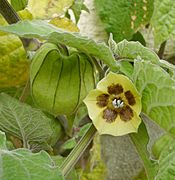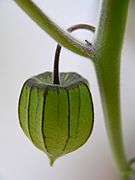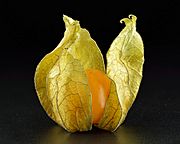Physalis peruviana facts for kids
Quick facts for kids Physalis peruviana |
|
|---|---|
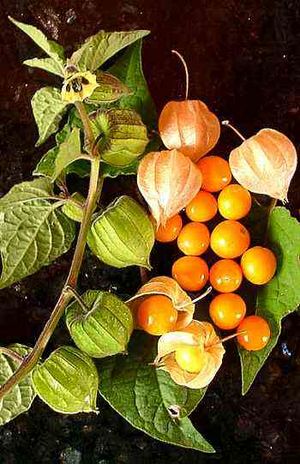 |
|
| Ripe orange fruits | |
| Scientific classification | |
| Genus: |
Physalis
|
| Species: |
peruviana
|
| Synonyms | |
|
|
Physalis peruviana, is a South American plant native to Colombia, Ecuador and Peru in the nightshade family (Solanaceae), commonly known as Cape gooseberry or goldenberry, known in its countries of origin as aguaymanto, uvilla or uchuva, in Hawaii called poha, and in Egypt called Harankash, in addition to numerous indigenous and regional names. The goldenberry is also known as ground cherry. The history of P. peruviana cultivation in South America can be traced to the Inca Empire. It has been cultivated in England since the late 18th century, and in South Africa in the Cape of Good Hope since at least the start of the 19th century. Widely introduced in the 20th century, P. peruviana is cultivated or grows wild across the world in temperate and tropical regions.
Contents
Taxonomy and common names
Physalis peruviana was first formally named by Carl Linnaeus in 1763.
The plant was grown in England in 1774 and by early settlers of the Cape of Good Hope before 1807. Whether it was grown there before its introduction to England is not known, but sources since the mid-19th century attribute the common name "Cape gooseberry" to this fact. One suggestion is that the name properly refers to the calyx surrounding the fruit like a cape, possibly an example of false etymology, because it does not appear in publications earlier than the mid-20th century. Not long after its introduction to South Africa, P. peruviana was introduced into Australia, New Zealand, and various Pacific islands. Despite its name, it is not botanically related to the true gooseberries of the genus Ribes.
P. peruviana has dozens of common names across the world in its regions of distribution. For example, in Peru it is known as aguaymanto in Spanish, or topotopo in Quechua. In neighboring Colombia, it is known as uchuva. In northeastern China Heilongjiang Province, it is informally referred to as deng long guo ("lantern fruit"). In French, it is called amour en cage ("love in a cage"), as well as other possible names, such as coqueret, alkékenge, or lanterne chinoise ("Chinese lantern") (also used for other Physalis, such as Physalis alkekengi), cerise de terre ("ground cherry"), or tomatillo (also used for Physalis philadelphica).
Description
P. peruviana is closely related to the tomatillo. As a member of the plant family Solanaceae, it is related to a large number of edible plants, including tomatoes, eggplants, and potatoes.
P. peruviana is an annual in temperate locations, but perennial in the tropics. As a perennial, it develops into a diffusely branched shrub reaching 1–1.6 m (3 ft 3 in – 5 ft 3 in) in height, with spreading branches and velvety, heart-shaped leaves. The hermaphrodite flowers are bell-shaped and drooping, 15–20 mm (0.59–0.79 in) across, yellow with purple-brown spots internally. After the flower falls, the calyx expands, ultimately forming a beige husk fully enclosing the fruit.
The fruit is a round, smooth berry, resembling a miniature yellow tomato 1.25–2 cm (0.49–0.79 in) wide. Removed from its calyx, it is bright yellow to orange in color, and sweet when ripe, with a characteristic, mildly tart grape- or tomato-like flavor.
A prominent feature is the inflated, papery calyx enclosing each berry. The calyx is accrescent until the fruit is fully grown; at first, it is of normal size, but after the petals fall, it continues to grow until it forms a protective cover around the growing fruit. If the fruit is left inside the intact calyx husks, its shelf life at room temperature is about 30–45 days. The calyx is inedible.
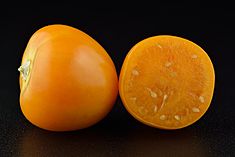 |
|
| Nutritional value per 100 g (3.5 oz) | |
|---|---|
| Energy | 222 kJ (53 kcal) |
|
11.2 g
|
|
|
0.7 g
|
|
|
Protein
|
1.9 g
|
| Vitamins | Quantity
%DV†
|
| Vitamin A equiv. |
5%
36 μg |
| Thiamine (B1) |
10%
0.11 mg |
| Riboflavin (B2) |
3%
0.04 mg |
| Niacin (B3) |
18%
2.8 mg |
| Vitamin C |
13%
11 mg |
| Minerals | Quantity
%DV†
|
| Calcium |
1%
9 mg |
| Iron |
8%
1 mg |
| Phosphorus |
6%
40 mg |
|
Link to USDA Database entry
|
|
| †Percentages estimated using US recommendations for adults. | |
Distribution and habitat
The center of genetic diversity for Physalis peruviana is to the Andes Mountain regions of Chile, Colombia, Peru. It grows in forests, forest edges, and riparian areas. It grows at high elevations of 500–3,000 m (1,600–9,800 ft) in its native region, but may also be found at sea level in Oceania and Pacific islands where it occurs widely in subtropical and warm, temperate conditions. Its latitude range is about 45°S to 60°N, and its altitude range is generally from sea level to 3,000 m (9,800 ft). The plant has become invasive in some natural habitats, forming thickets, particularly in Hawaii and on other Pacific islands. There are believed to be dozens of ecotypes worldwide that differentiated by plant size, calyx shape, and the size, color, and flavor of the fruit. Wild forms are thought to be diploid with 2n = 24 chromosomes, while cultivated forms include varieties with increased ploidy and 32 or 48 chromosomes.
Cultivation
It has been widely introduced into cultivation in tropical, subtropical, and temperate areas such as Australia, China, India, Malaysia, and the Philippines. P. peruviana thrives at an annual average temperature from 13–18 °C (55–64 °F), tolerating temperatures as high as 30 °C (86 °F). It grows well in Mediterranean climates and is hardy to USDA hardiness zone 8, meaning it can be damaged by frost. It grows well in rainfall amounts from 800–4,300 mm (31–169 in) if the soil is well drained, and prefers full sun or partial shade in well-drained soil, and grows vigorously in sandy loam.
The plant is readily grown from seeds, which are abundant (100 to 300 in each fruit), but with low germination rates, requiring thousands of seeds to sow a hectare. Plants grown from year-old stem cuttings will flower early and yield well, but are less vigorous than those grown from seed.
Pests and diseases
In South Africa, cutworms attack the Cape gooseberry in seedbeds, red spiders in the field, and potato tuber moths near potato fields. Hares damage young plants, and birds eat the fruits. Mites, whiteflies, and flea beetles can be problematic. Powdery mildew, soft brown scale, root rot, and viruses may affect plants. In New Zealand, plants can be infected by Candidatus liberibacter subsp. solanacearum.
Culinary uses
P. peruviana is an economically useful crop as an exotic exported fruit, and is favored in breeding and cultivation programs of many countries. P. peruviana fruits are marketed in the United States as goldenberry and sometimes Pichuberry, named after Machu Picchu in order to associate the fruit with its origin in Peru.
Cape gooseberry is made into fruit-based sauces, pies, puddings, chutneys, jams, and ice cream, or eaten fresh in salads and fruit salads. In Latin America, it is often consumed as a batido or smoothie, and because of its showy husk, it is popular in restaurants as a decorative garnish for desserts. To enhance its food uses, hot air drying improved qualities of dietary fiber content, texture, and appearance.
In basic research on fruit maturation, the content of polyphenols and vitamin C varied by cultivar, harvest time, and ripening stage.
Nutrition
According to nutrient analyses by the USDA, a 100 g serving of Cape gooseberries is low in food energy (222 kilojoules or 53 kilocalories) and contains moderate levels of vitamin C, thiamin, and niacin, while other nutrients are negligible (see table). Analyses of oil from different berry components, primarily its seeds, showed that linoleic acid and oleic acid were the main fatty acids, beta-sitosterol and campesterol were principal phytosterols, and the oil contained vitamin K and beta-carotene.
See also
 In Spanish: Uchuva para niños
In Spanish: Uchuva para niños



